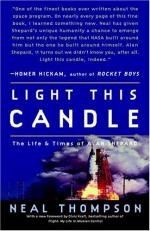|
This section contains 264 words (approx. 1 page at 300 words per page) |
American Astronaut 1923-1998
Alan Bartlett Shepard Jr. was America's first human in space and the fifth of only twelve men to walk on the Moon. His combination of professionalism and impish sense of humor vaulted him to the status of space hero, and he became a symbol of perseverance to the world.
A graduate of the U.S. Naval Academy, test pilot, and flight instructor, Shepard was selected as one of the original seven Mercury astronauts. At the age of thirty-seven, he was launched atop a Redstone rocket, May 5, 1961. The tiny Mercury capsule soared to an altitude of 116 miles (187 kilometers). The 15-minute sub-orbital flight demonstrated that a human could survive and function in the weightlessness of space. The success of Shepard's mission inspired U.S. President John F. Kennedy's challenge to the nation to land men on the Moon by the end of the decade.
 Alan Shepard was the United States' first astronaut in space.
Alan Shepard was the United States' first astronaut in space.
After an ear problem grounded Shepard for many years, he finally returned to space as commander of Apollo 14 in 1971 aboard the giant Saturn V Moon rocket, 111-meters (363-feet) high compared to his 83-foot (25-meter) Redstone, bringing back 43 kilograms (94 pounds) of Moon rocks. Shepard left behind two golf balls hit with a cleverly devised golf club. Alan Shepard died July 22, 1998 from leukemia.
Sickness See Medicine (Volume 3).
See Also
Astronauts, Types of (Volume 3);; Capsules (Volume 3);; Mercury Program (Volume 3).
Bibliography
Englebert, Phillis. Astronomy and Space, Vol. 3. Detroit: UXL, 1997.
Shepard, Alan B., and Deke Slayton. Moon Shot. Atlanta: Turner Publishing, 1994.
Internet Resources
|
This section contains 264 words (approx. 1 page at 300 words per page) |


